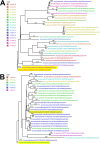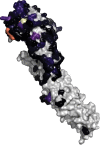Machine Learning Prediction and Experimental Validation of Antigenic Drift in H3 Influenza A Viruses in Swine
- PMID: 33731472
- PMCID: PMC8546707
- DOI: 10.1128/mSphere.00920-20
Machine Learning Prediction and Experimental Validation of Antigenic Drift in H3 Influenza A Viruses in Swine
Abstract
The antigenic diversity of influenza A viruses (IAV) circulating in swine challenges the development of effective vaccines, increasing zoonotic threat and pandemic potential. High-throughput sequencing technologies can quantify IAV genetic diversity, but there are no accurate approaches to adequately describe antigenic phenotypes. This study evaluated an ensemble of nonlinear regression models to estimate virus phenotype from genotype. Regression models were trained with a phenotypic data set of pairwise hemagglutination inhibition (HI) assays, using genetic sequence identity and pairwise amino acid mutations as predictor features. The model identified amino acid identity, ranked the relative importance of mutations in the hemagglutinin (HA) protein, and demonstrated good prediction accuracy. Four previously untested IAV strains were selected to experimentally validate model predictions by HI assays. Errors between predicted and measured distances of uncharacterized strains were 0.35, 0.61, 1.69, and 0.13 antigenic units. These empirically trained regression models can be used to estimate antigenic distances between different strains of IAV in swine by using sequence data. By ranking the importance of mutations in the HA, we provide criteria for identifying antigenically advanced IAV strains that may not be controlled by existing vaccines and can inform strain updates to vaccines to better control this pathogen.IMPORTANCE Influenza A viruses (IAV) in swine constitute a major economic burden to an important global agricultural sector, impact food security, and are a public health threat. Despite significant improvement in surveillance for IAV in swine over the past 10 years, sequence data have not been integrated into a systematic vaccine strain selection process for predicting antigenic phenotype and identifying determinants of antigenic drift. To overcome this, we developed nonlinear regression models that predict antigenic phenotype from genetic sequence data by training the model on hemagglutination inhibition assay results. We used these models to predict antigenic phenotype for previously uncharacterized IAV, ranked the importance of genetic features for antigenic phenotype, and experimentally validated our predictions. Our model predicted virus antigenic characteristics from genetic sequence data and provides a rapid and accurate method linking genetic sequence data to antigenic characteristics. This approach also provides support for public health by identifying viruses that are antigenically advanced from strains used as pandemic preparedness candidate vaccine viruses.
Keywords: antigenic drift; influenza A; machine learning; molecular epidemiology; swine; viral evolution.
Figures





Similar articles
-
Substitutions near the hemagglutinin receptor-binding site determine the antigenic evolution of influenza A H3N2 viruses in U.S. swine.J Virol. 2014 May;88(9):4752-63. doi: 10.1128/JVI.03805-13. Epub 2014 Feb 12. J Virol. 2014. PMID: 24522915 Free PMC article.
-
The Molecular Determinants of Antibody Recognition and Antigenic Drift in the H3 Hemagglutinin of Swine Influenza A Virus.J Virol. 2016 Aug 26;90(18):8266-80. doi: 10.1128/JVI.01002-16. Print 2016 Sep 15. J Virol. 2016. PMID: 27384658 Free PMC article.
-
Evolution and Antigenic Advancement of N2 Neuraminidase of Swine Influenza A Viruses Circulating in the United States following Two Separate Introductions from Human Seasonal Viruses.J Virol. 2021 Sep 27;95(20):e0063221. doi: 10.1128/JVI.00632-21. Epub 2021 Aug 11. J Virol. 2021. PMID: 34379513 Free PMC article.
-
[Swine influenza virus: evolution mechanism and epidemic characterization--a review].Wei Sheng Wu Xue Bao. 2009 Sep;49(9):1138-45. Wei Sheng Wu Xue Bao. 2009. PMID: 20030049 Review. Chinese.
-
Genetic Diversity of the Hemagglutinin Genes of Influenza a Virus in Asian Swine Populations.Viruses. 2022 Apr 1;14(4):747. doi: 10.3390/v14040747. Viruses. 2022. PMID: 35458477 Free PMC article. Review.
Cited by
-
Data alchemy, from lab to insight: Transforming in vivo experiments into data science gold.PLoS Pathog. 2024 Aug 29;20(8):e1012460. doi: 10.1371/journal.ppat.1012460. eCollection 2024 Aug. PLoS Pathog. 2024. PMID: 39208339 Free PMC article. No abstract available.
-
Predicting Antigenic Distance from Genetic Data for PRRSV-Type 1: Applications of Machine Learning.Microbiol Spectr. 2023 Feb 14;11(1):e0408522. doi: 10.1128/spectrum.04085-22. Epub 2022 Dec 13. Microbiol Spectr. 2023. PMID: 36511691 Free PMC article.
-
PARNAS: Objectively Selecting the Most Representative Taxa on a Phylogeny.Syst Biol. 2023 Nov 1;72(5):1052-1063. doi: 10.1093/sysbio/syad028. Syst Biol. 2023. PMID: 37208300 Free PMC article.
-
Seasonal antigenic prediction of influenza A H3N2 using machine learning.Nat Commun. 2024 May 7;15(1):3833. doi: 10.1038/s41467-024-47862-9. Nat Commun. 2024. PMID: 38714654 Free PMC article.
-
Machine learning approaches for influenza A virus risk assessment identifies predictive correlates using ferret model in vivo data.Commun Biol. 2024 Aug 1;7(1):927. doi: 10.1038/s42003-024-06629-0. Commun Biol. 2024. PMID: 39090358 Free PMC article.
References
-
- Dykhuis- Haden C, Painter T, Fangman T, Holtkamp D. 2012. Assessing production parameters and economic impact of swine influenza, PRRS and Mycoplasma hyopneumoniae on finishing pigs in a large production system. Abstr Am Assoc Swine Veterinarians, Denver, CO.
Publication types
MeSH terms
Substances
Grants and funding
LinkOut - more resources
Full Text Sources
Other Literature Sources
Miscellaneous

